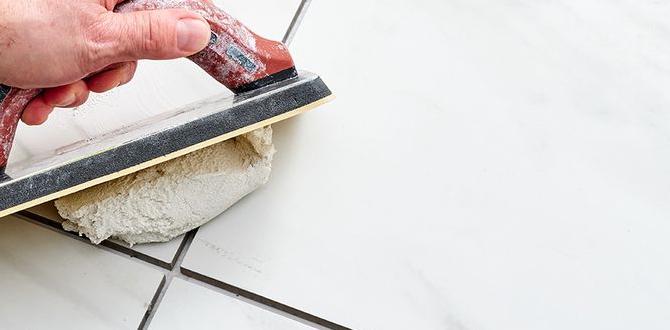Have you ever looked at a beautiful tiled wall or floor and wondered how it stays perfect? One big secret is grouting. Grouting tiles not only makes them look neat but also helps them last longer. It fills the gaps between tiles, keeping dirt and moisture out. You might think grouting is too hard to do, but it can be fun and easy!
Imagine transforming your bathroom or kitchen with just a little effort. It feels great to complete a DIY project, right? Plus, learning how to grout tiles can save you money! Instead of hiring someone, you can do it yourself.
In this article, we will show you how to grout tiles step by step. You will learn the tools needed and tips to make it easy. You might be surprised at how quick you can get beautiful results. Get ready to roll up your sleeves and make your tiles shine!
How To Grout Tiles: A Step-By-Step Guide For Success

How to Grout Tiles
Grouting tiles can seem tricky, but it doesn’t have to be. First, choose the right grout for your project. Mix it according to package instructions, then use a float to apply the grout evenly. Don’t forget to wipe off excess with a damp sponge. Did you know that grouting can help tiles stay in place? This simple process protects your lovely tiles and makes your space look polished. Ready to give it a try?
Understanding Grout
Definition and purpose of grout. Types of grout available (sanded vs. unsanded, epoxy, etc.).
Grout is a thick paste used to fill spaces between tiles. It helps hold them in place and keeps water from getting behind them. There are different types of grout:
- Sanded grout: This has sand for strength and is best for wider gaps.
- Unsanded grout: This is smooth and works well for small spaces.
- Epoxy grout: This is very strong and waterproof, making it great for wet areas.
What is the purpose of grout?
Grout secures tiles and prevents dirt and moisture from collecting.
Tools and Materials Needed
List of essential tools (float, sponge, mixing bucket). Recommended types of grout and their coverage.
To grout tiles, you need a few important tools and materials. First, a float helps you spread the grout smoothly. A sponge is great for cleaning excess grout from the tiles. Using a mixing bucket allows for easy preparation of your grout mix.
- Recommended Grout Types:
- Sand-based grout covers large spaces well.
- Non-sanded grout suits smaller joints.
- Epoxy grout is strong and waterproof.
Each type has its own coverage area, so check the package for details. For example, one bag usually covers about 150-200 square feet. Happy grouting!
What tools do you need for grouting?
You need a float, sponge, and mixing bucket to grout tiles.
Preparing the Tile Surface
Cleaning tiles and removing spacers. Ensuring proper drying time for thinset.
Start by cleaning the tile surface. Use a damp cloth to remove dust and dirt. This helps the grout stick well. Next, take out the spacers between the tiles. Spacers keep the tiles apart while the thinset dries. After that, it’s crucial to let the thinset dry properly. Wait at least 24 hours before grouting. This ensures the tiles stay in place.
Why is it important to clean tiles before grouting?
Cleaning tiles removes dirt and dust, allowing grout to stick better. A clean surface creates a strong bond. Without cleaning, the grout can crack or peel.
Steps to Prepare the Tile Surface:
- Wipe tiles with a damp cloth.
- Remove all spacers.
- Wait for thinset to dry completely.
Mixing the Grout
Stepbystep instructions for mixing grout. Tips for achieving the right consistency.
First, grab your mixing bucket and a mixing tool. Measure out the grout powder needed for your tiles. Then, add water slowly according to the instructions on the bag. Mix it well until it reaches a smooth, thick paste. Tip: The grout should not be too runny or too stiff. Perfect consistency feels like peanut butter. Remember to mix small batches at a time to use it fresh!
How do you know if the grout is mixed correctly?
You can check it by looking for a smooth and even texture. If it holds its shape and spreads easily, you’ve done it right!
Quick Mixing Tips:
- Use clean tools.
- Mix for 2-3 minutes.
- Let it sit for 10-15 minutes before use for best results.
Applying the Grout
Techniques for using a grout float. Working with different tile sizes and patterns.
Using a grout float is like wielding a magic wand for tile work. Hold it at a slight angle, then glide it across the tiles, filling in the spaces. With larger tiles, use more force to push the grout down. For smaller tiles or intricate patterns, be gentle and patient—no grout fairy will fix your mess! Remember, practice makes perfect. And don’t forget to clean as you go; grout can stick faster than your favorite gum under a school desk!
| Tile Size | Grout Application Technique |
|---|---|
| Large Tiles | Use more pressure for even fill |
| Small Tiles | Light touch, easy does it |
| Complex Patterns | Be patient, small strokes help |
Cleaning Up excess Grout
Best practices for wiping off excess grout. Timing for initial cleanup vs. final cleanup.
Cleaning excess grout is a key step for great-looking tiles. Start by wiping off extra grout while it’s still wet. Use a damp sponge and move in circles. This helps catch any leftovers before they dry. Wait about 30 minutes after applying the grout for the final cleanup. By then, it will be firm but not hard. Here are some best practices:
- Use a clean, moist sponge.
- Wipe gently to avoid removing grout from the seams.
- Rinse the sponge often to keep it clean.
How soon can I clean excess grout?
You can start cleaning 30 minutes after grouting. This timing helps you avoid messy problems later.
Sealing and Curing Grout
Importance of sealing grout lines. Recommended sealant types and application methods.
Sealing grout lines is important to protect them. It helps keep water and dirt from getting in. This makes your tiles last longer and look nicer. Using the right sealant is key. Here are some recommended types:
- Penetrating sealers: These soak into the grout and create a strong shield.
- Acrylic sealers: These form a protective layer on top of the grout.
- Epoxy sealers: These are very tough and work well in wet areas.
Apply the sealant after the grout cures fully. Use a small brush for even coverage. Let it dry completely. This simple step makes a big difference!
What is the purpose of sealing grout?
The purpose of sealing grout is to prevent stains and moisture. This keeps your tiles looking fresh and protects your investment.
How long does grout take to cure before sealing?
Grout usually takes about 24 to 72 hours to cure. It is best to wait the full time before sealing.
Common Mistakes to Avoid
Pitfalls during grouting process to watch out for. Tips for fixing mistakes.
Grouting tiles can be tricky. Avoid these common mistakes for a better finish:
- Not mixing the grout well can lead to uneven texture.
- Using too much water may weaken the grout.
- Ignoring gaps can cause future problems.
- Rushing the drying process may ruin your work.
If you make a mistake, don’t worry! You can fix it by:
- Regrouting when the first layer dries.
- Using a grout float to remove excess grout.
Remember, patience is key. Take your time to do it right!
What are some ways to fix grout mistakes?
If things go wrong, you can reapply grout once it’s dry.
Maintaining Grouted Tiles
Cleaning and upkeep of grouted surfaces. Recommended cleaning products and techniques.
To keep grouted tiles looking fresh, regular cleaning is key. Sweep or vacuum to remove dust and crumbs. For a deeper clean, mix warm water with a splash of vinegar or a gentle cleaner. Scrub the grout with a soft brush—this is not a wrestling match, so go easy! Rinse well, and watch the magic happen. Here’s a handy table of recommended products:
| Type | Cleaning Product |
|---|---|
| Natural | Vinegar & Water |
| Commercial | pH-balanced tile cleaner |
| Heavy Dirt | Baking Soda Paste |
Keeping grouted tiles clean doesn’t have to be hard work. Remember, a little love and elbow grease go a long way!
Conclusion
In summary, grouting tiles is simple and important. First, choose the right grout. Then, mix it properly. Apply it with a float and clean the tiles afterward. Don’t forget to let it cure! Now that you know how to grout tiles, you can start your project with confidence. For more tips, consider reading guides on tile maintenance!
FAQs
What Materials And Tools Do I Need To Properly Grout Tiles?
To grout tiles, you need a few simple tools and materials. First, get grout, which fills the spaces between tiles. You also need a grout float, which helps spread the grout evenly. Don’t forget a sponge and water for cleaning up. Lastly, have a bucket to mix the grout in.
How Do I Mix Grout To Achieve The Right Consistency For Application?
To mix grout, first, you need a clean bucket and a mixing tool, like a stick. Pour the grout powder into the bucket. Add water slowly while stirring until it looks like cake batter. If it’s too thick, add a little more water. If it’s too runny, add more grout powder. Make sure it’s all mixed well before using!
What Is The Best Technique For Applying Grout Between Tiles?
The best way to apply grout between tiles is to start with clean tiles. Use a rubber float to spread the grout. Hold the float at a 45-degree angle. Press the grout into the gaps between the tiles. Then, wipe off extra grout with a damp sponge. Let it dry completely before using the area.
How Long Should I Wait Before Wiping Off Excess Grout From The Tile Surface?
You should wait about 15 to 30 minutes after applying the grout. This gives it time to set a little. Then, you can use a damp sponge to wipe off the extra grout. Make sure not to press too hard, or you might remove grout from the gaps!
Are There Specific Tips For Sealing Grout Once It Has Dried?
Yes, there are tips for sealing grout after it dries. First, clean the grout lines to remove any dirt. Next, use a paintbrush or a small tool to apply the sealer. Make sure you cover all the grout evenly. Finally, let it dry as the instructions say. This will help keep your grout looking nice and last longer!








